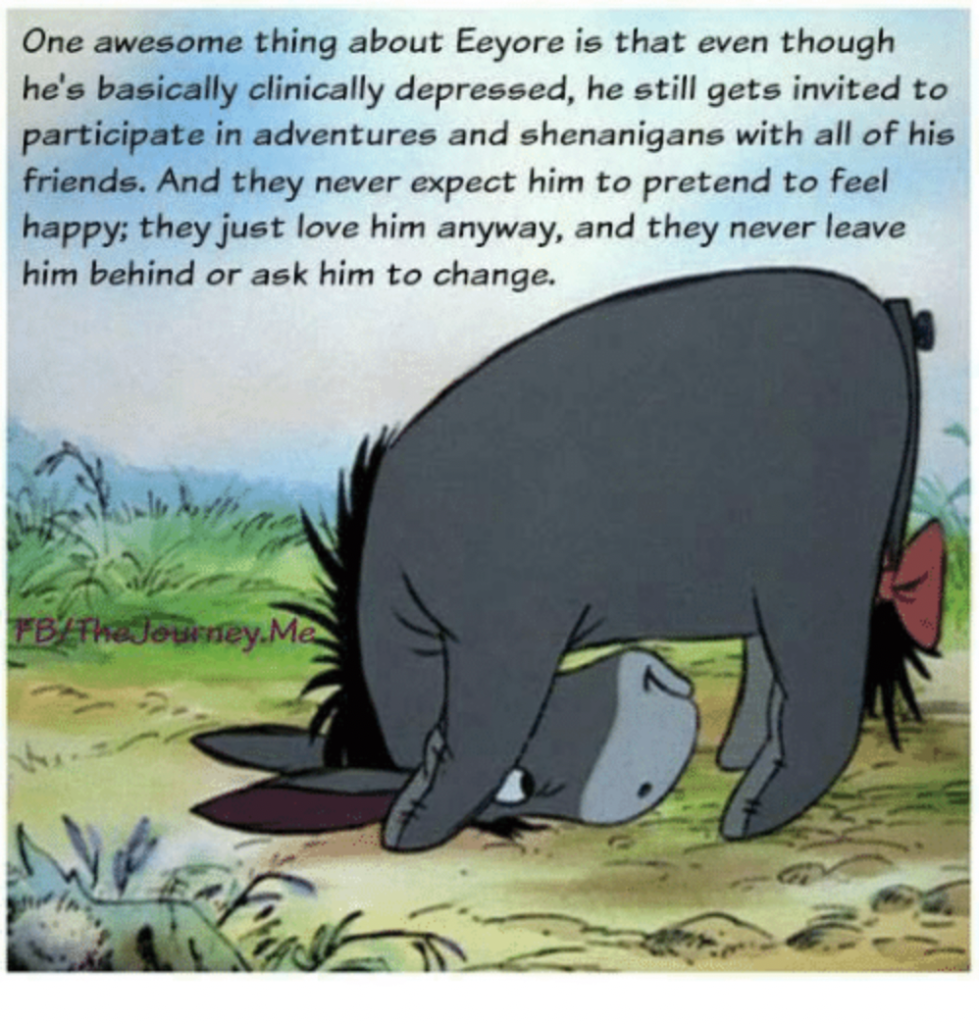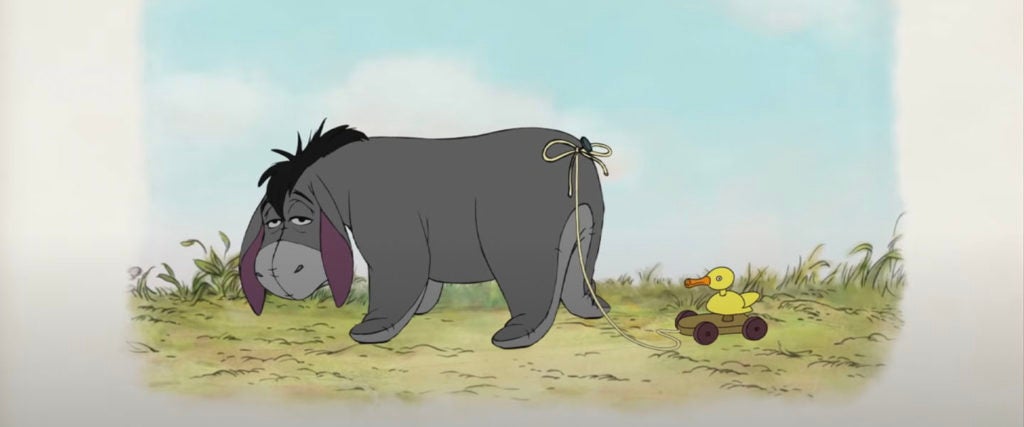If you look up “depression” in the dictionary, you might find Eeyore’s picture.
Statements like that tend to be said as a joke, or at least with some degree of hyperbole, but it pretty much holds true in Eeyore’s case. In reliable, scholarly descriptions of both dysthymia and dysphoria — two diagnoses related to depression — he’s been cited as an example of someone living with such conditions. He’s also been the subject of academic papers about depression, and the word “Eeyorish” is an official word in the Oxford English Dictionary for a person with a gloomy outlook.
Most recently, the beloved donkey has found himself as the subject of numerous depression-related memes, which, despite the overall cynicism of the internet, generally highlight him as a character who’s overcome a difficult struggle. Put quite simply, Eeyore is synonymous with depression, begging the question: How did the humble ungulate become the universally recognized Patron Saint of the Sad?

While memes are the latest format to diagnose Eeyore, they’re far from the first. In 2015, the college thesis of Ball State University student Rachel C. Smith gained some notoriety online for its in-depth analysis of the psychology of Winnie the Pooh and his friends. Of Eeyore, Smith wrote that he “seems to have the psychological disorder known as chronic dysthymia. … He has chronic negativism, low energy and anhedonia. He would benefit greatly from an antidepressant, possibly combined with individual therapy.”
Smith’s thesis expanded upon a scientific paper, “Pathology in the Hundred Acre Wood: A Neurodevelopmental Perspective on A.A. Milne,” published 15 years earlier in the Canadian Medical Association Journal. Although intended to be lighthearted, the piece presented a serious, scientific analysis to the psychology of Pooh and his pals and, because of the official nature of the Canadian Medical Association Journal, the paper became famous worldwide.
In 2000, “Pathology in the Hundred Acre Wood” went the pre-Twitter version of viral, and this is likely when Eeyore became solidified in the public consciousness as a mascot of the clinically depressed. That said, it wasn’t the first published work to link him with depression. “Eeyorish” became an expression in Britain in the 1990s, and I found works citing Eeyore as being depressed from the 1980s, 1970s and 1960s, too. This suggests that the idea isn’t born out of academics reading too far into a children’s story, but that the original texts clearly portray the little donkey as suffering from a serious mental-health disorder.
Eeyore first appeared in the 1926 book Winnie-the-Pooh by Milne. The word “depressed” or “depression” doesn’t appear in any of Milne’s original stories, but Eeyore’s first appearance pretty clearly describes his condition:
“The Old Grey Donkey, Eeyore, stood by himself in a thistly corner of the forest, his front feet well apart, his head on one side, and thought about things. Sometimes he thought sadly to himself, ‘Why?’ and sometimes he thought, ‘Wherefore?’ and sometimes he thought, ‘Inasmuch as which?’ — and sometimes he didn’t quite know what he was thinking about.”
Most often, Milne describes Eeyore’s emotions as “sad” or “melancholy,” but psychology professor Caleb Lack tells me that his demeanor pretty accurately portrays the condition of dysthymia, as the two viral papers suggested. Per Lack, “Dysthymia is a type of depression characterized by a pretty steady, low-grade depression, which is in contrast to Major Depressive Disorder, where people have depressive episodes that might last for weeks or months, but then those episodes will subside.”
What’s impressive about Milne’s portrayal of Eeyore — particularly for the time in which it was written — is that Eeyore’s depression wasn’t played for laughs, which is in direct contrast with other types of emotions and psychological conditions seen in cartoons of the time. For example, Donald Duck is full of rage, but we delight in seeing him get pissed off. Much the same can be said of Porky Pig’s nervous stammering. Eeyore, however, is mostly met with compassion from his friends.
The simple reason for this may be that depression isn’t all that exciting to portray. “It’s not particularly entertaining to show someone going through withdrawal or sleeping 16 hours in a day,” Lack says. “Other disorders, however, can more easily be made fun or dramaticized.” This might also be why there seems to be so few, if any, other depressed cartoon characters (Sadness, from Pixar’s Inside Out, might be the only other character who fits the bill, yet she’s still too new to reach Eeyore’s level of fame). To Lack’s point, Eeyore isn’t nearly as “entertaining” as the bouncy, fun-loving Tigger, yet it’s to Milne’s credit that Eeyore was still included as a major character in his stories.
A recent analysis of Milne’s work suggests that Eeyore’s sadness may be symbolic of Milne’s own PTSD from World War I, where the author fought in one of its bloodiest battles. “If Milne does indeed convey complex post-war topics such as PTSD and depression through his Winnie-the-Pooh tales, Eeyore is an easy way to illustrate to children how not everyone is happy all of the time,” wrote author Alex Tomb of the educational organization Cove.
More universally, author Elizabeth Baker — who wrote the book Living With Eeyore: How to Positively Love the Negative People in Your Life — tells me that the sadness of Eeyore speaks to “the bit of sadness in all of us.” She adds that since these characters are nearly universally known in the English-speaking world, Eeyore’s sadness is a common reference point that generations of people can identify with.
While Eeyore can speak to that bit of sadness that we all carry, Lack says that he can also represent something particularly special for those who suffer from depression. “With any representation, it helps people to realize that they’re not alone and that’s important whether you’re talking about racial characteristics or mental health,” he tells me. He adds that the simplicity of the character makes it all that much easier for people to identify with. It’s hard to see yourself in other depressed characters like Tony Soprano, a violent mob boss, but for a kid who’s suffering from depression, it’s easy to relate to Eeyore, who’s dealing with complex emotions in simple stories.
Most poignantly, however, Baker tells me that “in life, it’s important to realize that the Eeyores of the world are giving you things and helping you out. They have something to say. You can’t be positive and bouncy all the time and their negativity can provide a balance that you need.”
Which is to say, Eeyore isn’t just an icon for depression because everybody knows him and people can identify with him. He’s an icon because he’s portrayed as having value in those stories — his most impressive trait of all.

